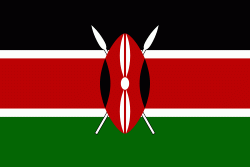Migori District (Migori)
Migori County is a county in the former Nyanza Province of southwestern Kenya. It is located in Southwestern Kenya and borders Homa Bay County (North), Kisii County (North E), Narok (South East), Tanzania (West and South) and Lake Victoria to the West. The county also borders Uganda via Migingo Island in Lake Victoria. The county is headquartered by Migori town, which is also its largest town. The Kenya National Census of 2019 indicated that Migori County had a population of 1,116,436 compared to 917, 170 in 2009 Census. Migori County is located in the sugar belt wetlands of Western Kenya and is mostly at the heart of the African tropics. However, the county enjoys a pleasant climate because of high altitude which modifies the climate alongside the cool breeze from Lake Victoria.
Demographically, Migori County is the most diverse region of Nyanza after Kisumu. The inhabitants include AbaSuba people, Joluo, Abakuria, Abagusii, Abaluhya, Somalis, Indians, Arabs, Agikuyu and Nubians.
The county is important to Kenya because of the significance of Isebania border post to the East African economy, the A-1 Kenya-Tanzania cuts the county in half, the place of Sony (South Nyanza) Sugar Company in the lives of over one hundred thousand households in Kenya, the influential role of Lake Victoria on food sustainability of Western region of Kenya, and its sizeable meat industry courtesy of the ranches in Kurialand and Suna West.
Migori town serves as in important link between Kenya and Tanzania and the second most viable commercial center in Luo-Nyanza after Kisumu. Other major towns in Migori county include Kehancha, Rongo, Awendo and Isebania in Kuria District.
Migori Town (-1.0634,34.4731) is 368 kilometers from Nairobi. Migori town is bordered by hills.
Water bodies in the county include the Kuja and Migori rivers, and Lake Victoria.
Demographically, Migori County is the most diverse region of Nyanza after Kisumu. The inhabitants include AbaSuba people, Joluo, Abakuria, Abagusii, Abaluhya, Somalis, Indians, Arabs, Agikuyu and Nubians.
The county is important to Kenya because of the significance of Isebania border post to the East African economy, the A-1 Kenya-Tanzania cuts the county in half, the place of Sony (South Nyanza) Sugar Company in the lives of over one hundred thousand households in Kenya, the influential role of Lake Victoria on food sustainability of Western region of Kenya, and its sizeable meat industry courtesy of the ranches in Kurialand and Suna West.
Migori town serves as in important link between Kenya and Tanzania and the second most viable commercial center in Luo-Nyanza after Kisumu. Other major towns in Migori county include Kehancha, Rongo, Awendo and Isebania in Kuria District.
Migori Town (-1.0634,34.4731) is 368 kilometers from Nairobi. Migori town is bordered by hills.
Water bodies in the county include the Kuja and Migori rivers, and Lake Victoria.
Map - Migori District (Migori)
Map
Country - Kenya
 |
 |
| Flag of Kenya | |
Kenya's earliest inhabitants were hunter-gatherers, like the present-day Hadza people. According to archaeological dating of associated artifacts and skeletal material, Cushitic speakers first settled in Kenya's lowlands between 3,200 and 1,300 BC, a phase known as the Lowland Savanna Pastoral Neolithic. Nilotic-speaking pastoralists (ancestral to Kenya's Nilotic speakers) began migrating from present-day South Sudan into Kenya around 500 BC. Bantu people settled at the coast and the interior between 250 BC and 500 AD. European contact began in 1500 AD with the Portuguese Empire, and effective colonisation of Kenya began in the 19th century during the European exploration of the interior. Modern-day Kenya emerged from a protectorate established by the British Empire in 1895 and the subsequent Kenya Colony, which began in 1920. Numerous disputes between the UK and the colony led to the Mau Mau revolution, which began in 1952, and the declaration of independence in 1963. After independence, Kenya remained a member of the Commonwealth of Nations. The current constitution was adopted in 2010 and replaced the 1963 independence constitution.
Currency / Language
| ISO | Currency | Symbol | Significant figures |
|---|---|---|---|
| KES | Kenyan shilling | Sh | 2 |
| ISO | Language |
|---|---|
| EN | English language |
| SW | Swahili language |















